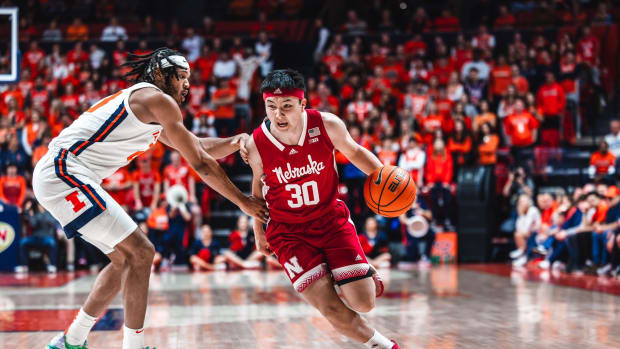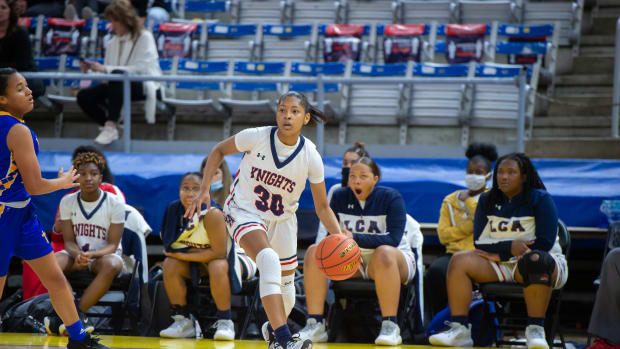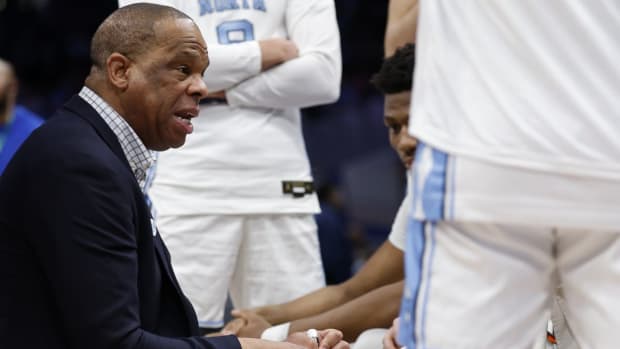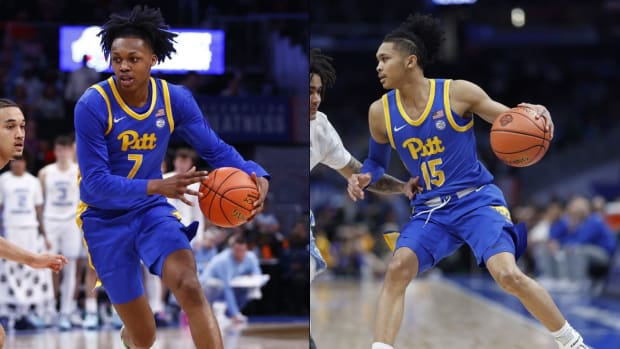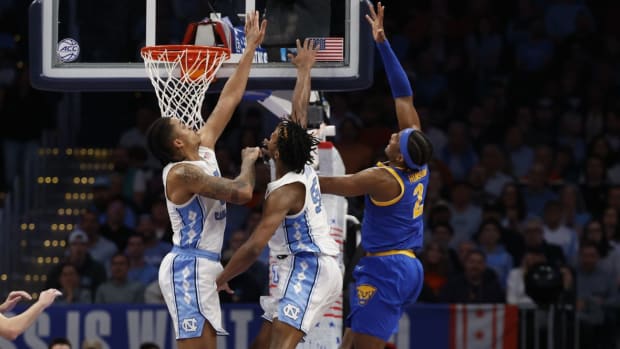After a suspension, Allonzo Trier is back to his high-scoring ways for Arizona
This story originally appeared in the March 27-April 3, 2017 issue of Sports Illustrated. Subscribe to the magazine here.
The 12-passenger rental van was parked outside, already packed with all of Allonzo Trier’s clothes and his vast collection of basketball sneakers. He didn’t want to waste any more of the evening celebrating his high school graduation. He just wanted to get to college. And so on May 14, 2015, at the conclusion of the diploma dinner Findlay Prep held for its five seniors at the Main Street Casino in Las Vegas, Trier and his mother, Marcie, and her fiancé, Derick Doss, hopped in the van and hit the road, heading southeast through the desert. It was approximately 8:30 p.m. when they started, and stopping only for gas and bathroom breaks, they arrived at Arizona’s campus around 3:30 a.m.
Trier grabbed four hours of sleep, then got up to begin the process—starting with a physical and a blood test—of getting cleared to train with the Wildcats. “Allonzo has been raised to be an all-or-nothing kid,” says Marcie. “For him, there was no thought of taking any time off; it was all about getting prepared for what was ahead.”
Sweet 16 Power Rankings: Who's most likely to win the national championship?
Two years later, as the starting two guard in Arizona’s quest to make its first Final Four since 2001, the 6' 5" Trier is not always the star—that is often Finnish 7-footer Lauri Markkanen—but he is what’s known as a bucket-getter, the guy coach Sean Miller calls on to create shots when the offense stagnates. That was the case against No. 7 seed Saint Mary’s in the second round in Salt Lake City, where Trier delivered nine of the Wildcats’ 11 points in a late-second-half run that turned a two-point deficit into a seven-point lead and sealed a 69–60 victory. That extended what Trier calls “the toughest season of my life,” in which he was forced to do something entirely unnatural: wait, indefinitely, to get on the court.
For their 2016–17 opener on Nov. 11, the Wildcats flew to Honolulu to play Michigan State in the Armed Forces Classic. The game had a fittingly classic finish, with senior point guard Kadeem Allen going coast-to-coast for a tiebreaking layup with 1.9 seconds left. After the buzzer sounded on Arizona’s 65–63 win, Allen was mobbed by most of his teammates, but Trier was not among them. He was 3,000 miles away in his apartment in Tucson, watching the game on his couch along with one of his roommates, sophomore student manager Eli Friedman. After Allen hit that layup, Trier jumped up and ran around the apartment celebrating, but the rest of the game, Friedman says, “was so hard for him to watch. He’s the ultimate gym rat, and you could tell: He was itching to play.”
Trier was fully healthy but was not allowed to travel with the team or to play in games. He was mired in what Miller would later describe as “a once-in-a-lifetime situation.”
That situation began last off-season, after Trier chose not to declare for the NBA draft following a freshman season in which he averaged 14.8 points. In May his mother helped him lease his first car, a white 2016 Mustang with a black top. Trier was thrilled to finally have a way to get around Tucson—until Sept. 1, when the Mustang was totaled in a front-end collision that Marcie calls “a serious accident, the kind of scary thing that makes you not take your life for granted.”
Later in September, according to SI’s sources, Trier was subjected to a random drug test by the NCAA, which informed him in October that he’d tested positive for a performance-enhancing drug. “I was shocked,” he says, “because I had no clue how it was in my system. I was like, What do you mean? There’s no possible way.” Gradually, he says, he pieced it together: Following the car accident, someone whom he called (in a January statement released to the media) “a well-intentioned but misguided person not associated with the University [of Arizona]” gave him a banned substance in hopes of aiding his recovery. Trier declined to reveal what the PED was, but says, “I had no idea that I had taken anything wrong.”
According to NCAA rules, first-time PED offenders lose one year of eligibility and are unable to compete for 365 days from the date of the test. Trier—who, as he puts it, “lost my car and then was being told I’d lost my season”—appealed and successfully persuaded the NCAA that he had ingested the substance unknowingly. On Dec. 3 he was allowed to begin traveling with the Wildcats . . . but he was suspended from games until the PED was fully out of his system.
How Florida's Kasey Hill morphed from an offense-first guard into a shutdown defender
For more than two months—in which the Wildcats went 17–2—Trier’s season consisted of practice, regular drug tests and shooting workouts with student managers serving as rebounders. Trier tried to maintain a tough face around teammates but often broke down late at night, when he was alone. “I just never knew if it was going to end,” he says.
On Jan. 20, the day between games at USC and UCLA, the team bus pulled up to the Los Angeles Clippers’ training center in Playa Vista, Calif. Before the players disembarked for practice, Miller stood at the front and addressed them. “We just got some news from the NCAA,” junior point guard Parker Jackson-Cartwright recalls Miller saying. “Zo is coming back.”
The whole bus celebrated—except Trier. “We were all hugging Zo, telling him we loved him, and he teared up,” Jackson-Cartwright says. “He carries himself like a professional at the highest level, so that was the first time I’d seen him show that kind of emotion.”
From there the Cats tried to get back to normal. They went to practice, and the next day upset the Bruins 96–85. Trier came off the bench to score 12 points, grab seven rebounds and dish out four assists, and he rejoined the starting lineup on Feb. 8 for a home win over Stanford. The reintegration of Trier wasn’t entirely smooth; he needed time to get the feel back on his pull-up jumpers, and by disrupting an effective guard rotation, he briefly hindered the defense. But the Wildcats’ record didn’t suffer: They’ve gone 11–1 with Trier as a starter, including an impressive surge to the Pac-12 tournament title in which he averaged an efficient 20.7 points and was named the Most Outstanding Player. After spending much of his hoops career as an ahead-of-schedule prospect—he was the subject of a New York TimesMagazine story as a 13-year-old phenom, and he began playing in Nike’s prestigious, high school AAU circuit, the EYBL, as an eighth-grader—Trier proved he could play catch-up.
With no regrets after Indiana firing, Tom Crean looks ahead to next opportunity
In second-seeded Arizona’s first two tournament games in Salt Lake City, Trier scored 18 points in a 100–82 defeat of No. 15 seed North Dakota and 14 in the win over Saint Mary’s. Since his return on Jan. 21 he has been the Wildcats’ highest possession-user (at 24.3%, according to kenpom.com) and second-most efficient starter (with an offensive rating of 121.8, second only to Markkanen’s 130.2). With a potential showdown against Gonzaga’s No. 1–ranked D looming in the Elite Eight, Trier’s isolation offense could prevent Miller & Co. from being bounced from their third regional final in four years. Although he was kept off the court for what felt like forever, there’s still a way for Trier to have suited up for the majority of the Wildcats’ season: by getting them to a 39th game—which would take place just up the road from campus, in Glendale, Ariz., at the Final Four.


